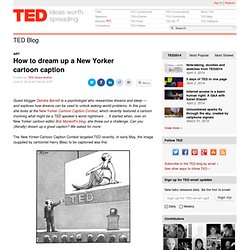

18 Things Highly Creative People Do Differently. This list has been expanded into the new book, “Wired to Create: Unravelling the Mysteries of the Creative Mind,” by Carolyn Gregoire and Scott Barry Kaufman. Creativity works in mysterious and often paradoxical ways. Creative thinking is a stable, defining characteristic in some personalities, but it may also change based on situation and context. Inspiration and ideas often arise seemingly out of nowhere and then fail to show up when we most need them, and creative thinking requires complex cognition yet is completely distinct from the thinking process. Neuroscience paints a complicated picture of creativity. As scientists now understand it, creativity is far more complex than the right-left brain distinction would have us think (the theory being that left brain = rational and analytical, right brain = creative and emotional). While there’s no “typical” creative type, there are some tell-tale characteristics and behaviors of highly creative people.
They daydream. They “fail up.”
Ina.fr : vidéo, radio, audio et publicité - Actualités, archives de la radio et de la télévision en ligne - Archives vidéo et radio Ina.fr. Ideas by Peter Watson - Asiaing.com: Free eBooks, Free Magazines, Free Magazine Subscriptions. Ideas: A History of Thought and Invention, from Fire to Freud, By Peter Watson.

HarperCollins, 2005. "This is a grand book...The history of ideas deserves treatment on this scale. " —Evening Standard (London) In this hugely ambitious and stimulating book, Peter Watson describes the history of ideas, from deep antiquity to the present day, leading to a new way of understanding our world and ourselves. The narrative begins nearly two million years ago with the invention of hand-axes and explores how some of our most cherished notions might have originated before humans had language. In the course of this commanding narrative, Watson reveals the linkages down the ages in the ideas of many apparently disparate philosophers, astronomers, religious leaders, biologists, inventors, poets, jurists, and scores of others. Download Ideas: A History of Thought and Invention, from Fire to Freud Excerpt, provided by HarperCollins.
PDF format, 2.6MB, 73Pages. About the Author. Genius or Madness? The Psychology of Creativity - Professor Glenn D. Wilson. Patrick Chappatte: The power of cartoons. Dan Pink: The puzzle of motivation. How to dream up a New Yorker cartoon caption. Guest blogger Deirdre Barrett is a psychologist who researches dreams and sleep — and explores how dreams can be used to unlock waking-world problems.

In this post, she looks at the New Yorker Cartoon Caption Contest, which recently featured a cartoon involving what might be a TED speaker’s worst nightmare … It started when, over on New Yorker cartoon editor Bob Mankoff’s blog, she threw out a challenge: Can you (literally) dream up a great caption? We asked for more: The New Yorker Cartoon Caption Contest targeted TED recently. In early May, the image (supplied by cartoonist Harry Bliss) to be captioned was this: ©Harry Bliss/New Yorker Collection 2012 While The New Yorker hasn’t announced the finalists yet for contest #336 (finalists will appear online June 11), the entry posted by TED speaker Roger Ebert on his own blog gives a taste of what to expect: I’ve spent more than a decade researching dreams and creativity.
©Robert Mankoff/The New Yorker Collection 2012. Matt Ridley: When ideas have sex. Ken Robinson: How schools kill creativity. John Cleese on Creativity.